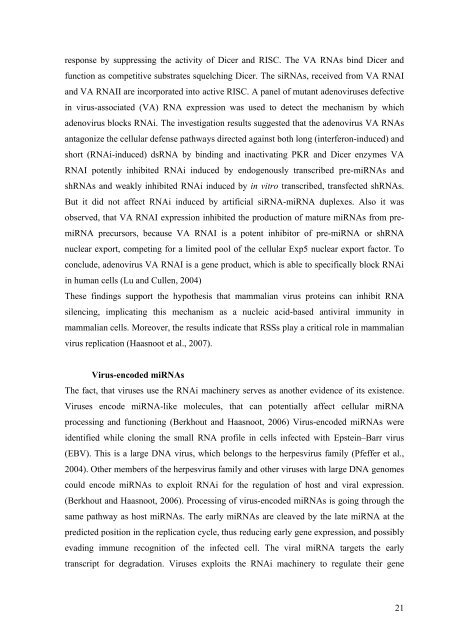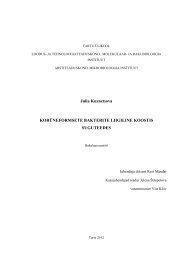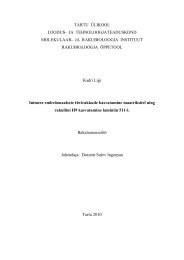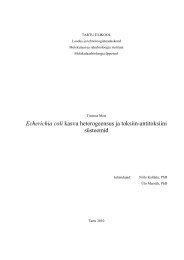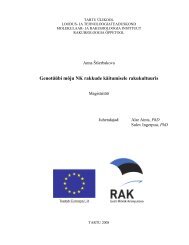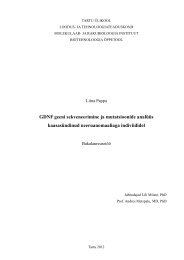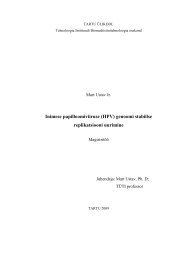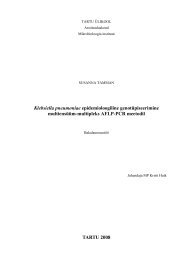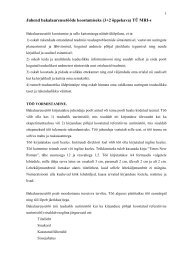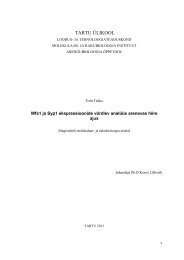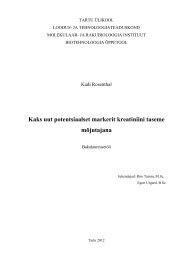Viruses and RNA interference in mammalian cells
Viruses and RNA interference in mammalian cells
Viruses and RNA interference in mammalian cells
Create successful ePaper yourself
Turn your PDF publications into a flip-book with our unique Google optimized e-Paper software.
esponse by suppress<strong>in</strong>g the activity of Dicer <strong>and</strong> RISC. The VA <strong>RNA</strong>s b<strong>in</strong>d Dicer <strong>and</strong><br />
function as competitive substrates squelch<strong>in</strong>g Dicer. The si<strong>RNA</strong>s, received from VA <strong>RNA</strong>I<br />
<strong>and</strong> VA <strong>RNA</strong>II are <strong>in</strong>corporated <strong>in</strong>to active RISC. A panel of mutant adenoviruses defective<br />
<strong>in</strong> virus-associated (VA) <strong>RNA</strong> expression was used to detect the mechanism by which<br />
adenovirus blocks <strong>RNA</strong>i. The <strong>in</strong>vestigation results suggested that the adenovirus VA <strong>RNA</strong>s<br />
antagonize the cellular defense pathways directed aga<strong>in</strong>st both long (<strong>in</strong>terferon-<strong>in</strong>duced) <strong>and</strong><br />
short (<strong>RNA</strong>i-<strong>in</strong>duced) ds<strong>RNA</strong> by b<strong>in</strong>d<strong>in</strong>g <strong>and</strong> <strong>in</strong>activat<strong>in</strong>g PKR <strong>and</strong> Dicer enzymes VA<br />
<strong>RNA</strong>I potently <strong>in</strong>hibited <strong>RNA</strong>i <strong>in</strong>duced by endogenously transcribed pre-mi<strong>RNA</strong>s <strong>and</strong><br />
sh<strong>RNA</strong>s <strong>and</strong> weakly <strong>in</strong>hibited <strong>RNA</strong>i <strong>in</strong>duced by <strong>in</strong> vitro transcribed, transfected sh<strong>RNA</strong>s.<br />
But it did not affect <strong>RNA</strong>i <strong>in</strong>duced by artificial si<strong>RNA</strong>-mi<strong>RNA</strong> duplexes. Also it was<br />
observed, that VA <strong>RNA</strong>I expression <strong>in</strong>hibited the production of mature mi<strong>RNA</strong>s from premi<strong>RNA</strong><br />
precursors, because VA <strong>RNA</strong>I is a potent <strong>in</strong>hibitor of pre-mi<strong>RNA</strong> or sh<strong>RNA</strong><br />
nuclear export, compet<strong>in</strong>g for a limited pool of the cellular Exp5 nuclear export factor. To<br />
conclude, adenovirus VA <strong>RNA</strong>I is a gene product, which is able to specifically block <strong>RNA</strong>i<br />
<strong>in</strong> human <strong>cells</strong> (Lu <strong>and</strong> Cullen, 2004)<br />
These f<strong>in</strong>d<strong>in</strong>gs support the hypothesis that <strong>mammalian</strong> virus prote<strong>in</strong>s can <strong>in</strong>hibit <strong>RNA</strong><br />
silenc<strong>in</strong>g, implicat<strong>in</strong>g this mechanism as a nucleic acid-based antiviral immunity <strong>in</strong><br />
<strong>mammalian</strong> <strong>cells</strong>. Moreover, the results <strong>in</strong>dicate that RSSs play a critical role <strong>in</strong> <strong>mammalian</strong><br />
virus replication (Haasnoot et al., 2007).<br />
Virus-encoded mi<strong>RNA</strong>s<br />
The fact, that viruses use the <strong>RNA</strong>i mach<strong>in</strong>ery serves as another evidence of its existence.<br />
<strong>Viruses</strong> encode mi<strong>RNA</strong>-like molecules, that can potentially affect cellular mi<strong>RNA</strong><br />
process<strong>in</strong>g <strong>and</strong> function<strong>in</strong>g (Berkhout <strong>and</strong> Haasnoot, 2006) Virus-encoded mi<strong>RNA</strong>s were<br />
identified while clon<strong>in</strong>g the small <strong>RNA</strong> profile <strong>in</strong> <strong>cells</strong> <strong>in</strong>fected with Epste<strong>in</strong>–Barr virus<br />
(EBV). This is a large DNA virus, which belongs to the herpesvirus family (Pfeffer et al.,<br />
2004). Other members of the herpesvirus family <strong>and</strong> other viruses with large DNA genomes<br />
could encode mi<strong>RNA</strong>s to exploit <strong>RNA</strong>i for the regulation of host <strong>and</strong> viral expression.<br />
(Berkhout <strong>and</strong> Haasnoot, 2006). Process<strong>in</strong>g of virus-encoded mi<strong>RNA</strong>s is go<strong>in</strong>g through the<br />
same pathway as host mi<strong>RNA</strong>s. The early mi<strong>RNA</strong>s are cleaved by the late mi<strong>RNA</strong> at the<br />
predicted position <strong>in</strong> the replication cycle, thus reduc<strong>in</strong>g early gene expression, <strong>and</strong> possibly<br />
evad<strong>in</strong>g immune recognition of the <strong>in</strong>fected cell. The viral mi<strong>RNA</strong> targets the early<br />
transcript for degradation. <strong>Viruses</strong> exploits the <strong>RNA</strong>i mach<strong>in</strong>ery to regulate their gene<br />
21


